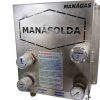
Complete Guide to Gas Mixers and its various applications
Why is TIG welding (GTAW) better than MIG welding (GMAW)?
The TIG welding (GTAW) and the MIG (GMAW) welding processes both use an electric arc, filler material (metals) and shielding gases to develop a weld bead. But their techniques, applications and finishes are very different. As with any welding project, the overall success depends on choosing the right processes and tools, so we have developed a list of positive points to make it easier to choose the TIG welding instead of the MIG welding.
TABLE OF CONTENTS:
Why is TIG welding (GTAW) better than MIG welding (GMAW)?
1. TIG welding (GTAW) X MIG (GMAW) welding – SUMMARY
TIG process is ideal for welding thinner metals and small parts because the GTAW process is capable of producing accurate and clean parts. Regarding torch control, MIG welding is generally easier to control and is better for beginners. TIG welders need to have experience with synchronization and balancing materials in both hands. On the other hand, TIG welding is better in terms of mechanical strength, quality and external surface finish.
To fully understand the MIG welding process advantes, please follow the link: https://www.managas.com.br/blog/porque-solda-mig-e-melhor-que-solda-tig/
2. TIG welding- QUALITY
MIG welding has the advantage of productivity, while TIG welding focuses on quality. The TIG weld is capable of producing a thin and clean bead, being able to weld details of reduced dimensions. TIG weld works very well on a wide variety of thin materials, such as aluminum and stainless steel alloys, and is the ideal choice for grooved and detailed parts such as weapons, toolboxes, repairs or ornamental parts.
Additionally, TIG welding has been conquering large industries that have precision parts and equipment, such as transportation, aerospace and military.
3. TIG – ACCURACY/DETAILS REPRODUCING
TIG welding process can achieve this level of precision because the operator has more control over the gun than in MIG welding. Unlike the MIG gun, which contains the electrode and filler metal in a system, TIG welding uses a non-consumable tungsten electrode to form the arc. The filler metal must be added separately, which allows the operator to precisely control the speed and depth of the weld.
The details also come from the operator’s control over the heat of the arc. Using a pedal, the heat can be reduced so as not to cause damage to thin and thin metals. As you can imagine, however, this level of accuracy is not fast or easy. Using two hands and one foot requires more specialized training and experience than operating a MIG pistol – it also takes much longer to create the weld.
4. TIG welding – CLEANNESS
TIG welding is a cleaner process than MIG welding. In TIG welding, manual control of the filler metal eliminates the spatter that can happen in MIG welding. And, sometimes, TIG welding can be performed without using the filler metal.
In addition, TIG welding is also better for the environment and its operators. MIG welding can cause a lot of smoke and in some cases even sparks.
5. TIG welding – MECHANICAL PERFORMANCE
TIG welding process is used in high-tech industries, such as automotive and aerospace, due to its ability to produce strong, quality welds in fine materials.
As the operator has manual control over the filler metal, the spheres can be much smaller and cause less disruption to the surrounding metal. In addition, the control over heat production means that the weld can be strong without burning the metal and require rework.
6. TIG welding – Maintenance
TIG welding configurations use consumables which need to be cleaned between jobs. In fact, a torch, piece to be welded and impeccable workspace are essential to achieve the artistic finish that so many people love at TIG.
However, as the TIG weld does not have a continuous feed of the add-on material, this eliminates problems that can arise with the use of several moving parts, such as burning contact tips and tangling the add-on wire.
QUESTIONS related to “Why is TIG welding (GTAW) better than MIG welding (GMAW)?"
Any questions and comments related to “Why Is TIG welding (GTAW) better than MIG welding (GMAW)?, please feel free contact us at any time. In addition, please take this opportunity to explore our product line of high performance gas mixers for TIG welding (GTAW welding).

Gas mixer designed and manufactured for the welding process, which allows mixing between 02 gases, with flow rate and outlet pressure control. From 0 to 100% content adjustable gas mixing output.

Compact gas mixer designed and manufactured for the welding process, which allows mixing between 02 gases, with outlet flow rate control. From 0 to 100% content adjustable gas mixing output. Requires cylinder/first stage pressure regulators for both input gases.
